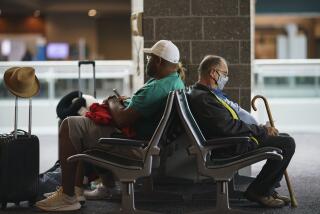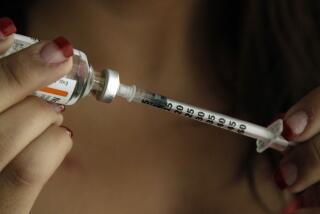If you’re diabetic, a little extra planning can ensure a safe trip
- Share via
For diabetics and their traveling companions, something as simple as a flight delay can complicate a trip -- or even make it dangerous.
Waiting for a late airline meal, crossing time zones, losing luggage -- these things that are mere annoyances for many travelers can wreak havoc on diabetics because of the potential effect on their blood-sugar levels. But experts such as Dr. Nathaniel Clark, spokesman for the American Diabetes Assn., say risks can be reduced if diabetics take the right precautions and if their traveling companions know what to do when faced with an emergency away from home.
About 13 million Americans have been diagnosed with the disease, according to the diabetes association, and 5.2 million more have the disease but do not know it. Most have Type 2 diabetes, in which the body fails to use properly the hormone insulin, crucial for converting sugar and other carbohydrates into energy. About 10% of those diagnosed with diabetes have Type 1, in which the body fails to produce insulin.
Both types of diabetics should take precautions when traveling, experts say. The most important step is to carry identification -- an ID card, bracelet or necklace -- that says you have diabetes. The ID is particularly crucial, Clark says, because the symptoms -- dizziness, fatigue, seizures and loss of consciousness -- are similar to those of alcohol intoxication.
Proper identification also is important given heightened airport security. Insulin, syringes and blood-glucose meters are allowed in carry-on and checked luggage under the Department of Homeland Security’s Transportation Security Administration rules. And many patients carry a doctor’s letter explaining their medication needs, says Dr. Osama Hamdy, director of the obesity clinic at the Joslin Diabetes Center in Boston.
One of the biggest mistakes insulin users make is not preserving it correctly, Hamdy says.
“Insulin should be kept cool all the time,” he says, recommending a storage container with coolant gel, available at sporting goods stores.
Some experts advise patients to pack twice the amount of insulin or medication they think they will need. Keep it in the original packaging to avoid snags at security checkpoints. Put it in carry-on luggage, not checked baggage, and if you’re traveling with someone, consider splitting medication between each other in case one person’s bag is lost or stolen. The diabetes association also advises travelers to carry copies of prescriptions.
An irregular dining and medication schedule is one of the most common anxieties, says Joan Hill, a registered dietitian and educator at the Joslin Diabetes Center. Because of the unpredictability of travel, she suggests that patients always carry snacks, meal replacements or both to avoid low blood sugar.
If traveling overseas, obtain a list of English-speaking doctors from the International Assn. for Medical Assistance to Travellers (www.iamat.org). The American consulate, your hotel or medical schools at your destination also may have a list of English-speaking doctors.
“I usually ask patients before they travel to get the phone and fax number of their healthcare professional,” says the Joslin Center’s Hamdy. The numbers allow a patient to ask questions, report blood-sugar problems or transmit their blood-sugar readings for evaluation.
Before departure, travelers bound for non-English-speaking countries also should learn a modicum of the local language -- at least enough to say “I have diabetes” and “sugar or orange juice, please.”
Healthy Traveler appears every other week. Kathleen Doheny can be reached at kathleen doheny@earthlink.net.
More to Read
Sign up for The Wild
We’ll help you find the best places to hike, bike and run, as well as the perfect silent spots for meditation and yoga.
You may occasionally receive promotional content from the Los Angeles Times.






